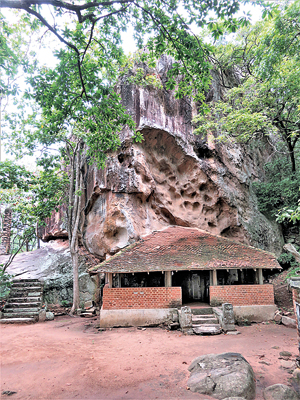A meditation in tranquillity

Soothing sight: A lone monk walking in the jungle
If you haven’t been to Sri Lanka’s monastery country yet, then you must.
It is where the Northwestern province meets the North Central. In the middle of nowhere, it is the area surrounding the ancient Rasvehera (Sasseruwa) temple that could be approached from the direction of known towns like Ibbagamuwa, Galgamuwa, Kalawewa or Tambuttegama.
Reaching Rasvehera from either of the above towns you will pass the little-known hamlets of Madagalle, Ahatu Wewa, Kathnoruwa, Meegalawa and Bulnawa. Roads to Rasvehera from any of the above hamlets are motorable but some may be better accessed in fair weather. Yet the hamlets are connected to the major towns by excellent roads.
The area is dominated by rocky outcrops clad in virgin Dry Zone forests. They have been left in that state since the 10th Century when the decline of the Anuradhapura kingdom began. All such outcrops have drip-ledged caves used by the monks for meditation and stone ruins of buildings can be seen as well. Some like the Rasvehera have caves where temples were enshrined in them by the ancient kings. What is visible now is mostly the restoration work carried out by the great King of Kandy, Keerthi Sri Rajasinghe in the middle of the 18th Century.
The cave temples have fascinating wall and ceiling frescoes, readable stone inscriptions and numerous unexplored historical artifacts scattered around dating back even to the pre-Christ era. It’s pleasing to note the way most such rocky outcrops have been converted into living monasteries now. There are over a dozen such in this landmass in focus.

Jungle monastery sheltered by a rocky outcrop
When one traverses the region extensively, it’s not uncommon to come across an acolyte accompanying a monk on a forest trail or monks engaged in walking meditation on rocky forest glades. Such sightings are so soothing to the eye. The remote villagers living close to the forest hermitages are quite used to the mendicants visiting their doorstep for the only meal the monks consume for the day. They consider it a privilege to part with a portion of their breakfast for them. Occasionally, on a prearrangement with the monastery, they would come with their kith and kin in a vehicle and offer the meal over a little ceremony in memory of a loved one who is no more. It’s a well-known tradition in this back of beyond country.
Elephants dominate this area for this is the main transit route of large herds travelling back and forth between the Kahalla mountain range and the newly established Kalawewa National Park. As such the forests surrounding the monasteries play an important role as fodder-rich corridors for the dwindling elephant population in migration. In addition to transiting herds, there are few old resident animals who prefer the untouched pockets of jungle to live out their days. Since the giants are a threat to the villages bordering the patches of wilderness, a fine network of electric fencing has been installed encircling the human settlements. Some villages are over 150 years old, and they have expanded with time, encroaching into the natural forests, claiming whatever that’s left. Their crops are mostly seasonal chena cultivation, but one finds traditional paddy cultivation as well in certain locations.

A picture of serenity
A couple of major commercial farms in the vicinity of Kahalla range, established in recent times are well protected by the electric fence.
The fishing cat and the otter are common in the jungles bordering the tanks not to mention jackal and all types of deer and civet. Of the amphibians, crocodile is common in the lakes as well as in rivers in addition to variety of snakes. The leopard may have survived at the Kahalla mountain range which is an exceptionally long block of a rock of considerable height spanning many a square kilometre. Despite the incredible forest canopy grown thickly over it, no leopard sightings have been recorded in recent times.

Carved out of rock: The towering Buddha statue at Rasvehera
The lakes are rich with aquatic bird life and so are the forests with endemic as well as rare migratory species adorning them during the northeast monsoon from November to March. It is the only monsoon that serves the region which makes the rest of the months free of any noteworthy showers. August is considered the driest when most of the waterbodies run dry.
The typical dry zone vegetation sees valuable timber as the top canopy under which exists several canopies of wild groves and thorny shrubs. The idyllic setting makes it ideal grounds for meditating monks to continue their strenuous pursuit of renouncing all desires and cravings.
Not much has changed in these parts except the electric barricading of human encroachments, the sight of which always leaves a pang in a nature lover’s heart. It is difficult to say whose freedom is curtailed by it – the elephants or the humans. It is a pity for many decades ago the two factions who are at loggerheads now are said to have lived in remarkable coexistence. Now they must be gravely mindful of one another for survival.
The forest monk living in isolation in a quiet monastery though, is hardly affected by the ongoing human-elephant conflict and like many before him, stays in focus in serene calmness until he reaches his goal of purity of mind and soul. But time is running out fast for the noble monk and the flora and fauna of this enchanting habitat before the destructive human race overruns this tranquil territory.
Searching for an ideal partner? Find your soul mate on Hitad.lk, Sri Lanka's favourite marriage proposals page. With Hitad.lk matrimonial advertisements you have access to thousands of ads from potential suitors who are looking for someone just like you.


